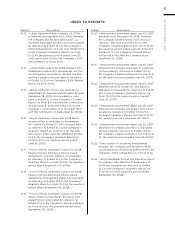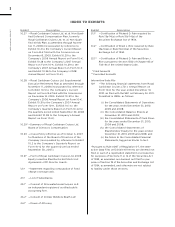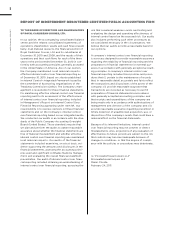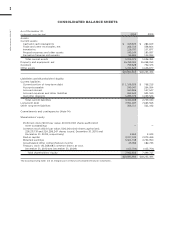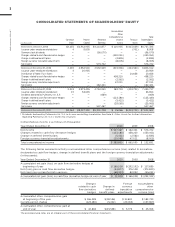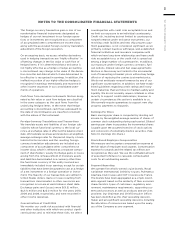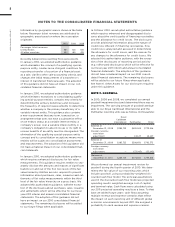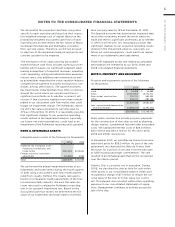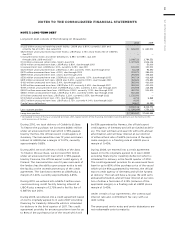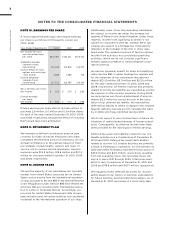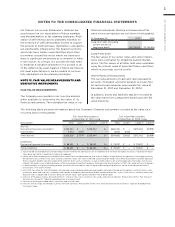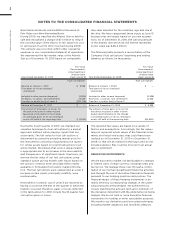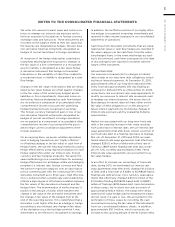Royal Caribbean Cruise Lines 2010 Annual Report Download - page 72
Download and view the complete annual report
Please find page 72 of the 2010 Royal Caribbean Cruise Lines annual report below. You can navigate through the pages in the report by either clicking on the pages listed below, or by using the keyword search tool below to find specific information within the annual report.
NOTES TO THE CONSOLIDATED FINANCIAL STATEMENTS
ROYAL CARIBBEAN CRUISES LTD. 69
The foreign-currency transaction gain or loss of our
nonderivative financial instruments designated as
hedges of our net investment in our foreign opera-
tions or investments are recognized as a component
of accumulated other comprehensive income (loss)
along with the associated foreign currency translation
adjustment of the foreign operation.
On an ongoing basis, we assess whether derivatives
used in hedging transactions are “highly effective” in
offsetting changes in the fair value or cash flow of
hedged items. If it is determined that a derivative is
not highly effective as a hedge or hedge accounting
is discontinued, any change in fair value of the deriva-
tive since the last date at which it was determined to
be effective is recognized in earnings. In addition, the
ineffective portion of our highly effective hedges is
recognized in earnings immediately and reported in
other income (expense) in our consolidated state-
ments of operations.
Cash flows from derivative instruments that are desig-
nated as fair value or cash flow hedges are classified
in the same category as the cash flows from the
underlying hedged items. In the event that hedge
accounting is discontinued, cash flows subsequent to
the date of discontinuance are classified consistent
with the nature of the instrument.
Foreign Currency Translations and Transactions
We translate assets and liabilities of our foreign sub-
sidiaries whose functional currency is the local cur-
rency, at exchange rates in effect at the balance sheet
date. We translate revenues and expenses at weighted-
average exchange rates for the period. Equity is trans-
lated at historical rates and the resulting foreign
currency translation adjustments are included as a
component of accumulated other comprehensive
income (loss), which is reflected as a separate compo-
nent of shareholders’ equity. Exchange gains or losses
arising from the remeasurement of monetary assets
and liabilities denominated in a currency other than
the functional currency of the entity involved are
immediately included in our earnings, except for certain
liabilities that have been designated to act as a hedge
of a net investment in a foreign operation or invest-
ment. The majority of our transactions are settled in
United States dollars. Gains or losses resulting from
transactions denominated in other currencies are
recognized in income at each balance sheet date.
Exchange gains and (losses) were $(9.5) million,
$(21.1) million and $23.0 million for the years 2010,
2009 and 2008, respectively, and were recorded in
other income (expense).
Concentrations of Credit Risk
We monitor our credit risk associated with financial
and other institutions with which we conduct signifi-
cant business and, to minimize these risks, we select
counterparties with credit risks acceptable to us and
we limit our exposure to an individual counterparty.
Credit risk, including but not limited to counterparty
nonperformance under derivative instruments, our
revolving credit facilities and new ship progress pay-
ment guarantees, is not considered significant, as we
primarily conduct business with large, well-established
financial institutions and insurance companies with
which we have long-term relationships and have credit
risks acceptable to us or the credit risk is spread out
among a large number of counterparties. In addition,
our exposure under foreign currency contracts, fuel
call options, interest rate and fuel swap agreements
that are in-the-money are limited to the incremental
cost of transacting at market prices without any hedge
offset or of replacing the contracts at market price.
We do not anticipate nonperformance by any of our
significant counterparties. In addition, we have estab-
lished guidelines regarding credit ratings and instru-
ment maturities that we follow to maintain safety and
liquidity. We do not normally require collateral or other
security to support credit relationships; however, in
certain circumstances this option is available to us.
We normally require guarantees to support new ship
progress payments to shipyards.
Earnings Per Share
Basic earnings per share is computed by dividing net
income by the weighted-average number of shares of
common stock outstanding during each period. Diluted
earnings per share incorporates the incremental shares
issuable upon the assumed exercise of stock options
and conversion of potentially dilutive securities. (See
Note 10. Earnings Per Share.)
Stock-Based Employee Compensation
We measure and recognize compensation expense at
the fair value of employee stock awards. Compensation
expense for awards and the related tax effects are
recognized as they vest. We use the estimated amount
of expected forfeitures to calculate compensation
costs for all outstanding awards.
Segment Reporting
We operate five wholly-owned cruise brands, Royal
Caribbean International, Celebrity Cruises, Pullmantur,
Azamara Club Cruises and CDF Croisières de France.
The brands have been aggregated as a single report-
able segment based on the similarity of their economic
characteristics, types of customers, regulatory envi-
ronment, maintenance requirements, supporting sys-
tems and processes as well as products and services
provided. Our Chairman and Chief Executive Officer
has been identified as the chief operating decision-
maker and all significant operating decisions including
the allocation of resources are based upon the analy-
ses of the Company as one segment.


